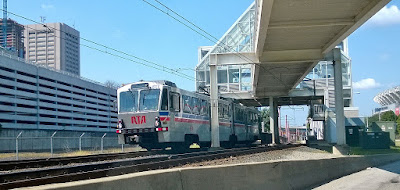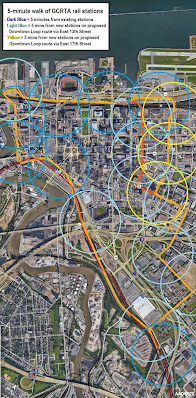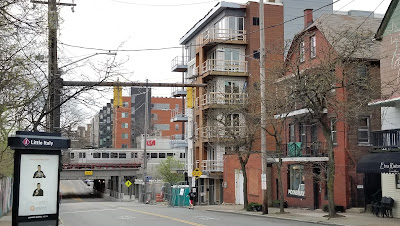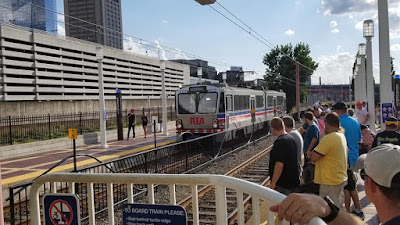In a recent letter, a downtown Cleveland community development corporation (CDC) urged the Greater Cleveland Regional Transit Authority (GCRTA) to revisit its 2000 Waterfront Line Phase II study that found extending the light-rail line as a Downtown Loop to be feasible.
The letter, sent Dec. 21 by the Campus District to GCRTA General Manager and CEO India Birdsong, followed a Dec. 11 vote by the CDC’s board of trustees to make the request of the transit authority. The CDC joined with the statewide nonprofit organization All Aboard Ohio in asking for a reevaluation of the proposed Downtown Loop as a 2.5-mile extension of the 2.2-mile Waterfront Line.
“We believe this could be a catalytic project for our neighborhood and would better connect our anchor institutions with each other, as well as connect the greater community to a thriving downtown,” Campus District Executive Director Mark Lammon wrote in the letter to GCRTA.
The Waterfront Line was built in 1996 for $70 million as an extension of the Shaker Heights-Tower City light-rail Blue and Green lines. Despite early ridership exceeding GCRTA’s projections, the Waterfront Line has not lived up to expectations since.
All Aboard Ohio, a passenger rail and transit advocacy association, argued that the rail line was never intended to end in the Municipal Parking Lot. The group said a range of options should be considered for the future of the rail line, but it favored the Downtown Loop.
The Waterfront Line is shut down for the winter as GCRTA began a major track reconstruction project in the Tower City Center station. The work has cut off track access to the Waterfront Line. But GCRTA opted not to provide interim bus service to Waterfront Line stations. The transit authority also will be refurbishing for $4 million a light-rail bridge over Front Street and the Norfolk Southern railroad tracks.
Abandonment of the Waterfront Line probably isn’t realistic. GCRTA would have to refund to the Federal Transit Administration up to $10 million in state-of-good-repair grants it used in the past decade to keep the rail infrastructure in a safe and operable condition, All Aboard Ohio contended in a briefing paper.
“GCRTA should consider expanding the Waterfront Line, as originally intended, to reach important destinations in and near Downtown Cleveland,” said All Aboard Ohio Executive Director Stu Nicholson in a written statement on its Web site. “Continuing the status quo is the only option GCRTA should not be embrace.”
At the Dec.11th board meeting of the Campus District, its directors voted to join with All Aboard Ohio in endorsing the reevaluation of the proposed Downtown Loop as an extension of the Waterfront Line. In 2000, GCRTA identified a preferred routing for the Waterfront Line Phase II, via East 17th Street, Prospect Avenue, East 22nd Street, Community College Avenue and East 30th Street.
But development of all of GCRTA’s major capital projects was halted in the recession of the early 2000s except for the HealthLine bus rapid transit on Euclid Avenue. It was already too far along to halt, Nicholson said.
“The investments that RTA has made in the Campus District have led to significant economic development,” Lammon continued. “The HealthLine was transformative to Euclid Avenue and continues to see development today. The Stephanie Tubbs Jones Transit Center and the reconstruction of the Tri-C-Campus District Rapid Station (at East 34th Street) have ensured that the district remains a transit hub.
“We believe that extending the Waterfront Line to the Campus District Rapid Station through our neighborhood would also continue this return on investment,” Lammon said.
He said the Downtown Loop will open new entryways into the central business district, expanding access to the Campus District’s vital jobs centers and diminishing the infrastructural divides leftover from redlining.
“We understand the challenges facing RTA today, however we believe that at least revisiting the 2000 Downtown Loop Study and determining its feasibility is worth considering the impact to our neighborhood and all of downtown,” Lammon concluded.
All Aboard Ohio said consideration of a Downtown Loop could be included as part of GCRTA’s ongoing Next Gen system planning and 2030 Strategic Planning processes. According to both groups, GCRTA has not yet responded to the Campus District CDC’s letter or to All Aboard Ohio’s Nov. 30 letter.
The 2000 Waterfront Line Phase II study showed that a Downtown Loop could produce enough ridership at relatively low costs to justify federal construction funds. Back then, the Federal Transit Administration looked favorably on transit expansions that had a cost per new rider lower than $20. The Downtown Loop was estimated at a cost per new rider of less than $14.
“That was before Downtown Cleveland increased its residential population by more than 100 percent, saw downtown employers grow with more than $7.25 billion worth of investment, and attracted new corporate offices from the suburbs and other metro areas,” Nicholson said. “And it was well before GCRTA considered replacing its rail fleet with a standard rail car that can travel on any of its five lines, plus future ones.”
Nicholson said that a significant part of a local funding share for the project might be raised from a short-term tax-increment financing district along the Downtown Loop. The 2000 study estimated that the Downtown Loop could attract 2.2 million square feet of nonresidential development, nearly 1,000 housing units, $441 million in overall development (in 2000 dollars), nearly 9,000 permanent jobs, $250 million in new payroll and $17.8 million in new local tax revenues per year.
Thanks to the federal CARES Act, GCRTA’s board recently passed a budget that could allow it to end 2021 with a $49 million reserve that will protect it from further emergencies and will probably also help it reduce its borrowing costs for major capital projects.
All Aboard Ohio also recently noted that Greater Cleveland will receive about $74 million in transit stimulus funds from the second round of federal pandemic aid. The advocacy group is urging that some of that money be used for transit-oriented developments near rail and bus stations, as well as reducing GCRTA’s significant state-of-good-repair backlog.
END














Comments are closed.